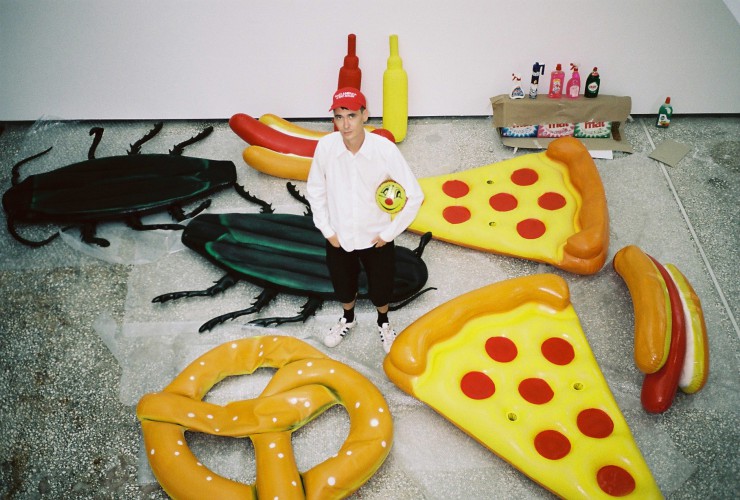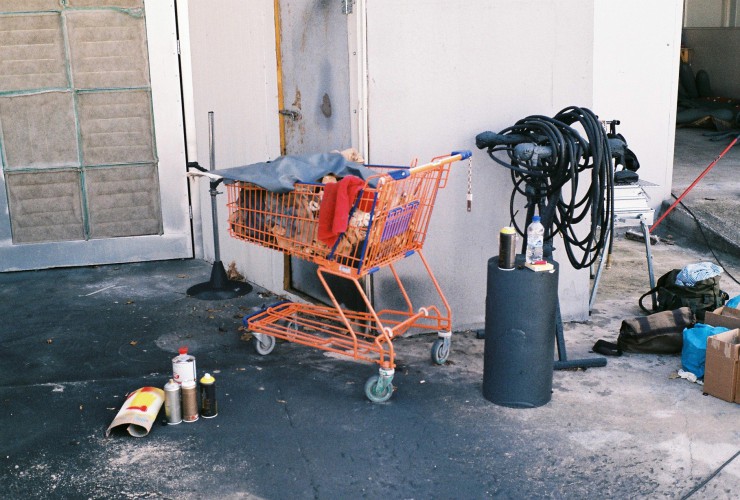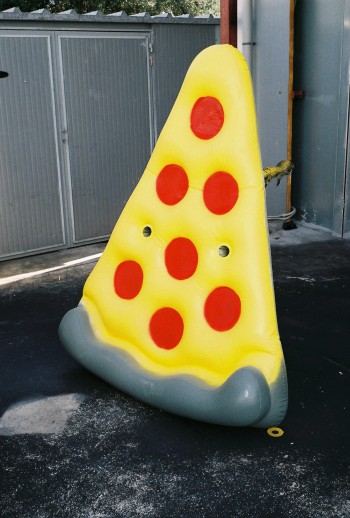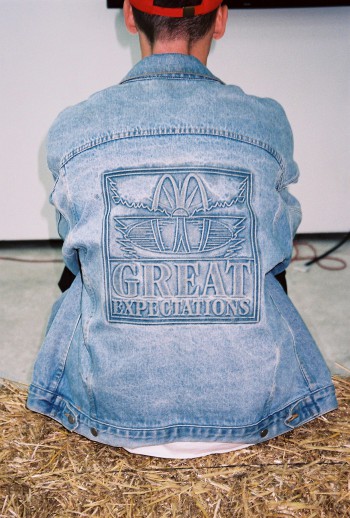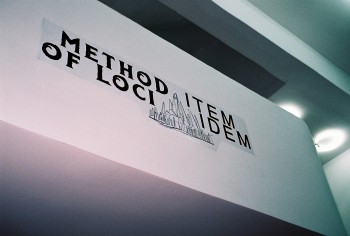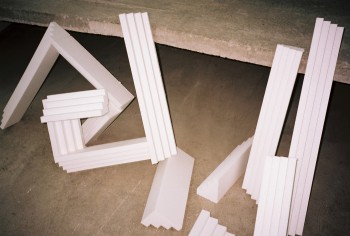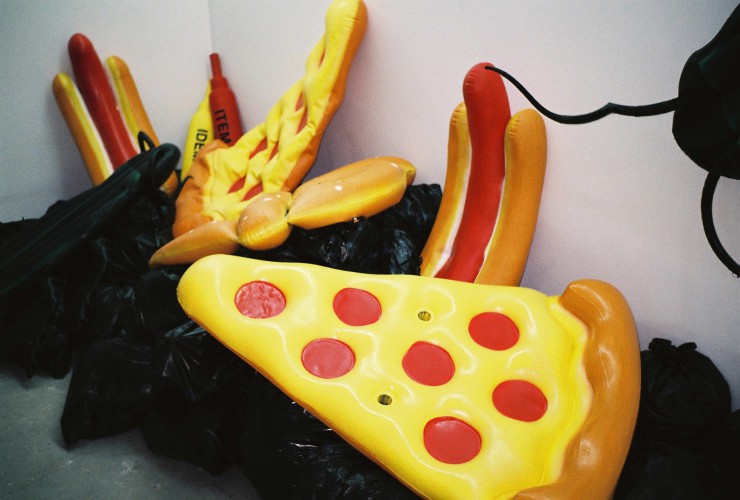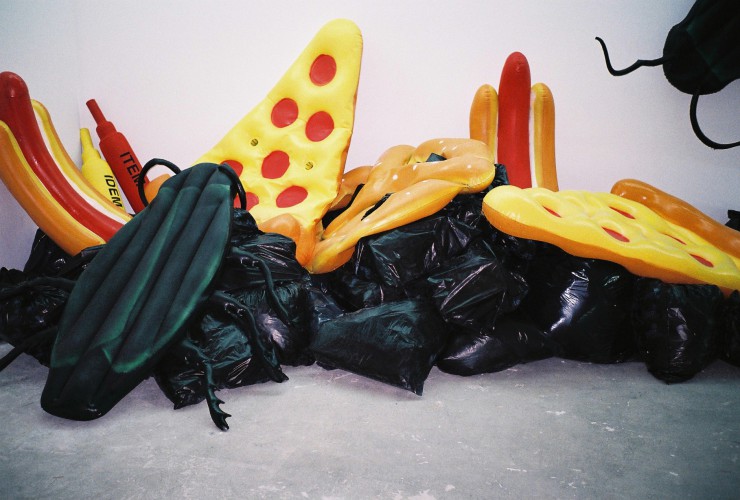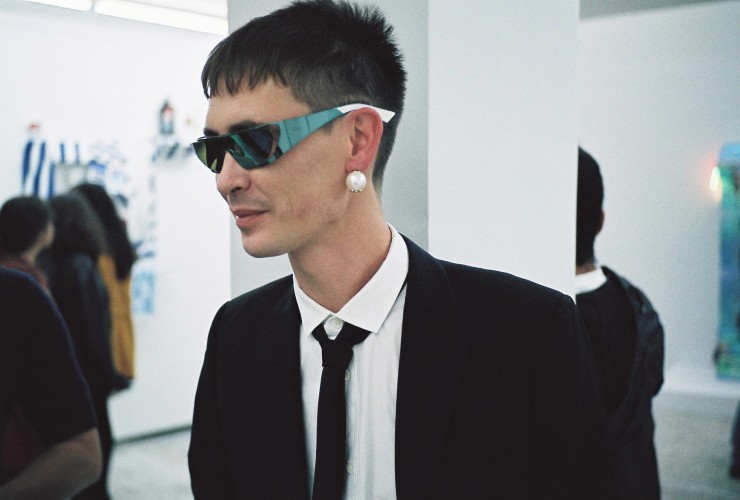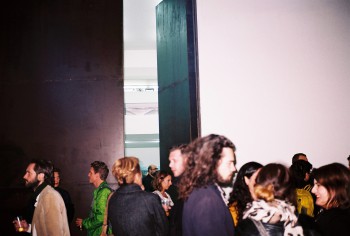Rarely does visual art behave in a way theater does, but occasionally it manages, and Method of Loci is one of those occasions. Cyril Duval aka item idem articulated the path between the past, present and future with mysticism, symbolism, and pop culture overtones. Method of Loci is an exhibition that shows us not how scary the world is but how ridiculous. Method of Loci is an ironic, ambiguous and powerful rendition of everything that is happening right now, with mostly politics and consumerism connotations. There is a great deal of art going on in politics ATM, Michael Moore even described Donald Trump as a “performance artist” because of how he adopts provocative postures in order to capture people’s attention, and Method of Loci is an answer and a reinterpretation of all of that. The current world state was item idem’s fuel to bring together a show that is designed with a perverted darkness and a comic originality of malformation. Each piece and artistic gesture in this show reference to something wider, but his past and present game kind of demonstrates of how little we have changed as a result of everything that is going on, and how little a humanism that exists only in the myths of the pop and the entertainment industry can counter its force. Method of Loci is an exhibition that has come to fill our entertainment surfaces: each piece is worth taking a second look, as the cultural references and the visual appearances item idem has given into this show, are imagination and intermingling of realities, at its best. Item idem is continually inventive; his work is exquisite and Method of Loci is his pilgrimage in physical state.
INTERVIEW: KATJA HORVAT
PHOTOGRAPHY: VASSILIS KARIDIS
Are you confident doing what you do?
Extremely. But at the same time, I am a Capricorn so by nature filled with complexity and very saturnine and versatile. I guess that’s what actually keeps me going in some way. I’m always motivated and I like taking a good challenge. I rarely surrender to difficulties and constantly find ways to create my own path. Without saying it’s always a walk in the park, though!
But I don’t believe in ‘commodity art or artists’ per se. The value of your work has to stand apart from the market trends you know? Or the media’s take on what’s hot or not. Been there, done that. Now I am just searching for more intellectual and emotional depth. I still want to create art forms that are equally sexy to me and the audience, but they also really have to trigger an intense emotional stimuli, like the intense cry of a crystal. If a crystal could cry! For instance, I am currently interested in the notion of spirituality when intertwined with the aesthetics of commerce through local folklores and rituals; or how commerce as a millenaries-old human notion is becoming the center point of a neo-materialistic philosophy through the ritualization of object culture.
What is your art about?
I’m not entirely sure. Emotional discharge, maybe!! More seriously, I like to consider myself as a growing human soul accumulating more experiences and knowledge as times goes by, so my art will always be the sum of all that. Then comes the artifices of all kinds: Staging and art direction, conceptual approaches, industrial techniques, pranks, storytelling and communication around the work.
Do you think you found your voice as an artist?
Yes, absolutely, although it’s always been a constant search for new ideas, new contents, new forms and techniques. In that sense, I feel like I have somehow lived several artistic lives already. There’s a huge difference between the artist that I am nowadays and the one I was ten years ago when I started. My approach to both physical or conceptual production – or the world in general – has considerably evolved, and the contents of my work are I believe quite different nowadays, albeit familiar to anyone who has been following me.
- ITEM IDEM, Crumbs, 2016. Readymade pool floats, polyurea hybrid elastomer, paint, varnish, garbage bags. Various dimensions
Are you easy to work with?
No, I don’t think I am particularly easy to work with. But to be honest, none of what I am doing is easy either: From the difficult topics I might be raising through my work to the problematics of creating challenging new sculptural works as a ‘young’ artist. No one said it was, or had to be easy! I am very demanding and expect a lot from people. It is somehow a bit challenging for external collaborators to cope with the fact that I request from them the same motivation and pressure that I put myself under. I truly understand that. But I am always polite, respectful, & thankful. I credit my collaborators as much as I am given the opportunity to, and whichever process we end up going through together, I always foresee the climax of the presentation as an opportunity to celebrate the amazing work we have achieved together.
Where does the process begin for you, when you are gearing up for a new show?
Current obsessions in any possible fields such as politics, science, or endless knowledge of random facts browsed online. Then usually a conceptual grid emerges that will become the axis of storytelling for the show and help define its lingo and its aesthetics. Then comes the design stage, or what I qualify as problem-solving: How will I present those ideas physically and which techniques to develop in order to precisely give shape to what I have in mind. But it all depends of course if we are talking about a gallery show, a branding project, an installation or set design etc.
‘Method of Loci’, your latest exhibition that just debuted at The Breeder gallery in Athens, is strongly intertwined with Greek mythology. Greek’s dealt with universal truths the way it was meaningful for any culture or individual, and you are now doing that with your show as well.
You are presenting universal truth in a language, and a manner, that can be meaningful and understood by anyone… So basically what I want to ask is – How did Method of Loci come about?
I simply got interested by this technique (and the romantic aesthetics associated with it) whilst looking for a vessel to encompass the various metaphysical and artistic notions I was playing with. It seemed at the time as the only metaphorical concept frame that would allow me to sum it all up in one storyline. Then I got really passionate with all interconnections I could find with Greek mythologies and pathways to discuss contemporary issues that were arousing me.
- ITEM IDEM and Kate Berlant, Make America a Hat Again, 2016. Readymade mannequin, embroidered cap, melted raincoat, branded tie, white shirt, wig, paint, varnish. 35 cm x 170 cm x 65 cm
‘Method of Loci’ is a known memory method (also known as Mind Palace technique) that was developed in Ancient Greece & Roman cultures. It is a technique in which a person visualizes the items they’re trying to learn in different spatial locations. To do this, the person associates the items with landmarks in some familiar place, which helps them recall the items later. So why this method in particular, how did you develop the structure for the exhibition, and what is the structure of Method of Loci, anyway?
Mostly my interest was into depicting the mnemonic device as a cartography of my brain and the accumulation of my human experiences reflecting on the time I live in. So the Method of Loci is here triggered as an allegory of the vault of information I have access to, and how I choose to contextualize these information into sculptural shapes or films to create commentaries or poetical alternatives: It acts as the conceptual grid (or ‘narrative red thread’) of the entire exhibition. This empiric use of the intangible notion of memory allows me to generate crossovers between many of the different symbolisms I have been looking at lately. There is quite a lot going on! Memento Mori, small monuments/shrines, conceptual taxonomies, but also agriculture, inflatables, piñatas, drones, praying mantises and roaches, fires and explosions.
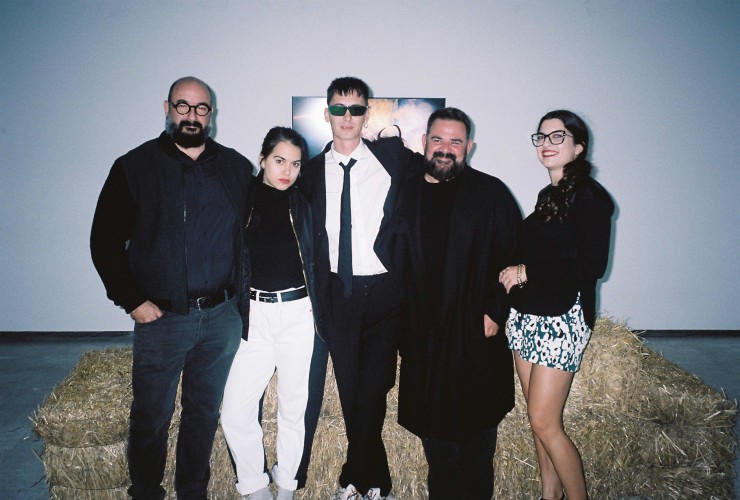 Cyril Duval with the gallery owners of THE BREEDER & Stamatia Dimatrakopoulos, the curator of the exhibition
Cyril Duval with the gallery owners of THE BREEDER & Stamatia Dimatrakopoulos, the curator of the exhibition
In what kinds of experiments did you engage in for ‘Method of Loci’?
Well, I believe that I have been using similar mnemonic skills since the past decade I have been working as an artist, for instance, whilst traveling all around the world sourcing objects and products that inspired me and combining them into larger works. So nothing really new here, except that I am trying to formulate these analyses in an upgraded version where some of the commentaries I am making tend to be more biting and aggressively explicit. This type of techniques feels very instinctive to me: My brain functions like a computer that scans the visual environment as quickly as possible and instantly isolate specific elements that could be meaningful to my work. As long as I wearing my viewing glasses and that I’m not tired, it is the most playful game and most direct part of my practice.
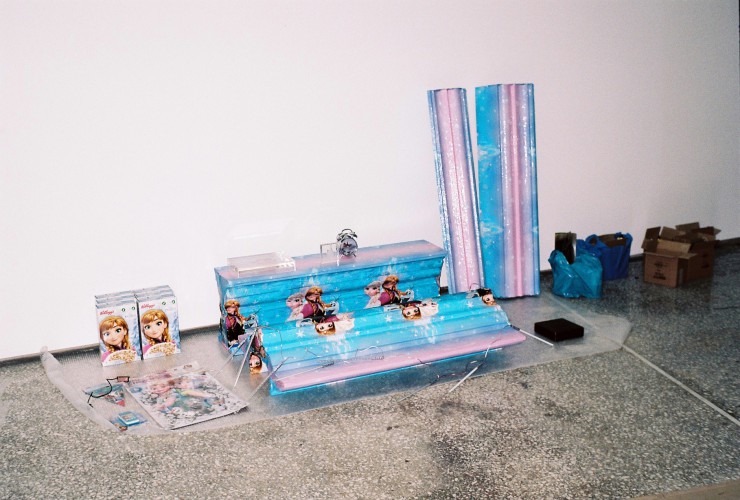 ITEM IDEM, Method of Loci, 2016. Puzzle, touristic memorabilia, cardboard sticker, branded plastic tablecloths, branded cereal boxes, iridescent foil, expanded polystyrene, polymethyl methacrylate, water-clear silicone rubber, LED lights. 125 cm x 180 cm x 66 cm
ITEM IDEM, Method of Loci, 2016. Puzzle, touristic memorabilia, cardboard sticker, branded plastic tablecloths, branded cereal boxes, iridescent foil, expanded polystyrene, polymethyl methacrylate, water-clear silicone rubber, LED lights. 125 cm x 180 cm x 66 cm
One of the focus points in your show is The Neuschwanstein Castle, that was built by King Ludwig II of Bavaria. King Ludwig was a great admirer and supporter of Richard Wagner and the Neuschwanstein Castle was built in his honor – many rooms in the castle’s interior were also inspired by Wagner’s characters. The Neuschwanstein Castle was also the influence behind the Walt Disney’s plans for the iconic Cinderella Castle and has been referenced in more recent Disney’s productions as well… So basically what I want to know is – Why this castle in particular?
Sadly, I haven’t been able yet to visit Neuschwanstein yet, but I visited one of its ‘siblings’ named the Pena Palace, which is in Sintra, not too far from Lisbon. Mostly the connection between Neuschwanstein and Disney was very appealing to me, as a starting point of the entire branding strategy of such an entertainment giant. Again, it became the archetypal aesthetic of the castle defining this notion of mind palaces and archival of memories in a broader sense.
I had to source the most iconic images to define my own branding that would exist within a parallel world of every reference I was quoting within my new works.
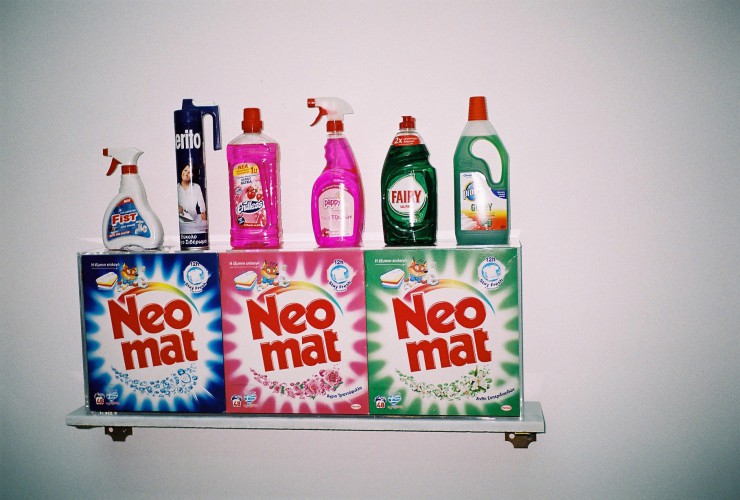 ITEM IDEM, Neo Materialism (Fist Merito Endless Pappy Fairy Glory), 2016. Collection of locally sourced packagings, polymethyl methacrylate, marble, iron. 95 cm x 65 cm x 15 cm
ITEM IDEM, Neo Materialism (Fist Merito Endless Pappy Fairy Glory), 2016. Collection of locally sourced packagings, polymethyl methacrylate, marble, iron. 95 cm x 65 cm x 15 cm
Even though you work holds strong and thorough history and cultural references, everything still looks very pop(y), and pop culture seems to be one of the strongest influence for you throughout you whole oeuvre. But as far as my understanding goes – your approach to the whole pop world is more about marketing, consuming, supply demanding stuff…. Am I right, or?
Well Pop is my art culture (or at least one of them), I embrace and breath it every possible way within my life and my practice, but somehow I find it more interesting to use it as a vector for my ideas which are somehow more tormented, or at least deeper than the childish first degree aesthetic of Pop itself. This was my main intention for this show: to channel this specific aesthetic but bend it my way to discuss urgent issues such as the intentional destruction of our ecosystem by the psychopaths ruling us, or the rise/return of new dangerous ideologies for our civilization. To be honest, I am proud of the show ended up turning like! It looks like bubblegum but taste like bitterness; it is biting, mildly scary and a little bit dangerous, which I think is the most interesting achievement here. I don’t make artworks for decorative purposes or to pleasure anyone’s eyes. As mentioned, good art needs to be sexy, but also deeply thought-provoking and perception-altering. As an artist, I am not interested in being involved with the notion of militance on the first degree, but I think I become a more powerful weapon & helpful to take down any sort of system if I do what I do best, which is Art.
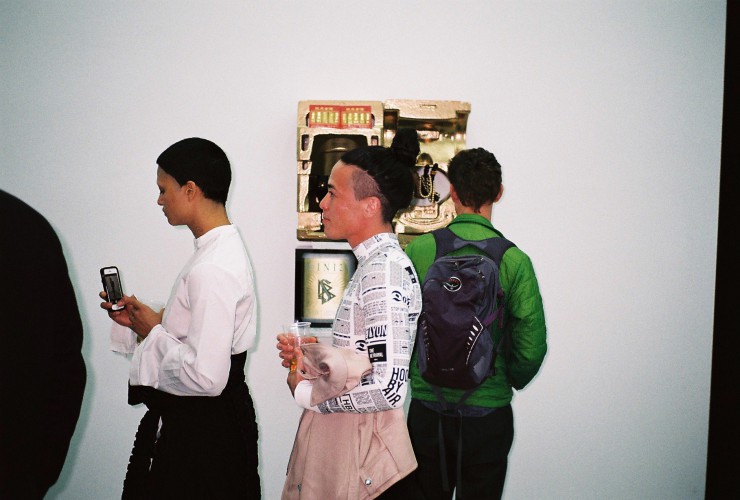 ITEM IDEM, Golden Fleece, 2016. Religious propaganda, ideological memorabilia, toys, costume jewelry, funeral paper craft, polymethyl methacrylate, expanded polystyrene, polyurea hybrid elastomer, marble, iron, paint, varnish, 75 cm x 102 cm x 25 cm
ITEM IDEM, Golden Fleece, 2016. Religious propaganda, ideological memorabilia, toys, costume jewelry, funeral paper craft, polymethyl methacrylate, expanded polystyrene, polyurea hybrid elastomer, marble, iron, paint, varnish, 75 cm x 102 cm x 25 cm
Let’s talk about the money for a second. One of your works entitled “Endless Economy (000000000000)” directly addresses the politics of austerity that are currently flagellating the Greek Economy. But art and money is a relationship on its own as well. Boris Groys once summarized the whole situation quite perfectly (with the focus on contemporary art), he talked about two stages – one stage being the spectacular auctions with remarkably high numbers and pieces being sold for large amounts of money, and the second stage – permanent and temporary exhibitions. He talked about how the number of large-scale, temporary exhibitions – biennials, triennials, Documenta, Manifestas – is constantly growing, but how all of the exhibitions listed are not primarily for art buyers, but for the general public. A similar situation has now happened in art fairs, as well. The initial plan/idea was that those fairs were meant to serve art buyers, but lately fairs like Frieze and Basel, for example, have increasingly transformed into public events attracting people with little interest in, or finances for, buying art. He then addresses the issue of financing the exhibitions – as they cannot be bought and sold, and exhibitions function beyond the art market, and for that reason require financial support, whether public or private. Oh ok, this is a very long explanation/question, but money is a very big problem among artists, and I would really like to hear you opinion on the whole situation….
You know the saying “Money, the nerve of the war”? Well, I have kept this closely in mind while producing Method of Loci. If I think about it, more than 80% of my show speaks about the power and influence money provides, from the establishment of corrupted systems of dominances to inequalities felt as shockwaves all around the planet. Being unaware of money and unable to use it wisely is not that different from being unaware of politics and unable to act swiftly on how to change the society. I am often quoted quoting Jenny Holzer’s truism ‘Use What is Dominant in a Culture To Change it Quickly’. Well, I somehow still live by this motto, even if it’s not happening as quickly as I desire!
Do you think that art and commerce can coexist?
Absolutely. Neither Michelangelo or Da Vinci would have accomplished all of their visions without the help of the (financial) powers that be. Hopefully, nowadays, me and my peers have more abilities to develop our practices through independent fundings & patrons, than simply being dependent from an entire religion like they were! So yes, I will always need more/new collectors, commissions from cultural institutions, or nicely paid projects with brands, although I am trying to slowly disengage from those little by little…
Is there a prevailing ideology for you right now?
In the end sequence of my new film ‘NUII’, there is a text piece which blurs two sentences into a 5 min visual crossfade: ’The End of Capitalism’ becoming ‘The Rise of Capitulism’, a neologism. Of course, I was more here in the search of a good word to inject a bit of humor to a very dark situation, but in a way, I find that nihilism and pessimism are overwhelmingly present nowadays. When you think about it, pretty much everyone exposed to proper information sources knows that WW3 started about a year ago with the invasion of Crimea and that the current Syrian theater might become the center point of a global conflict. Everyone knows Putin is pushing Trump as a puppet to lower the influence of NATO and push his neo-imperialist agenda forward. In a world of immediacy and interconnection, we have become hyperaware of the dangers but passivity is rising, like if we were actually physically living in a virtual world already! Not to turn this interview into an explanation of my political stances, but I believe a more dangerous ideology is at work nowadays, which I would qualify with another neologism of mine as ‘Permissivist’, with billionaires like Peter Thiel speaking publicly about how Democracy is an obstacle to Capitalism, or sadly someone like Slavoj Žižek who recently declared that he would rather vote for Trump than see Clinton elected, as the lesser of two evils.
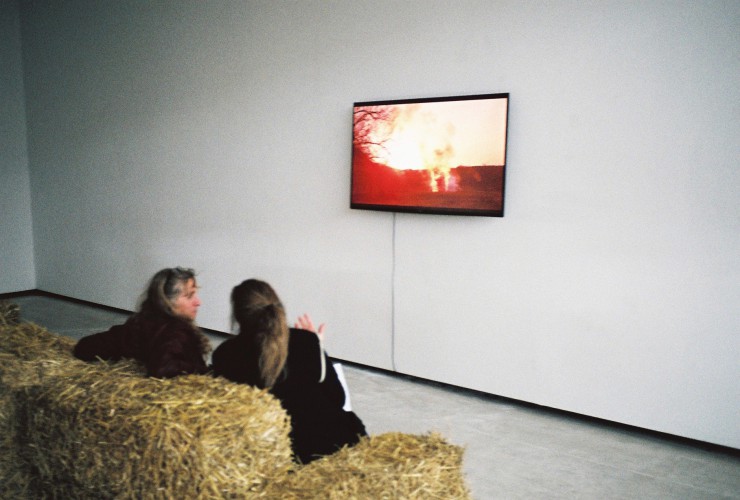 ITEM IDEM, NUII, 2016. HD film, 35 mins. Edition of 6+1 AP. Courtesy The Breeder Gallery.
ITEM IDEM, NUII, 2016. HD film, 35 mins. Edition of 6+1 AP. Courtesy The Breeder Gallery.
What is the last song you listened?
My friend the artist Navine G. Khan-Dossos sent me this morning a version of the “Ave Maria’ by Alessandro Moreschi, the late 19th-century castrato singer, which reminded her of my altered soundtrack of Maria Callas’ version for Cheng Ran and item idem’s film JOSS. She thought they shared similarities and she was absolutely right.
Last text you send?
Proposing my help to my friends Terence & Garrick as they are moving to California.
Favorite smell?
The smell of arid soil, after a heavy summer rain. Especially in south of France where I grew up. Or anything that triggers forgotten childhood memories. Feels like retiring within my own mind palace and enjoying a ‘Madeleine de Proust’, or how we like to say in French.
Favorite feel?
Completion! Like when I wrap a show for instance. This sensation is enhanced by the fact that it is highly ephemeral and soon to be replaced by ‘postpartum’ depression which unfortunately lasts longer. I also enjoy a light breeze under the sun when walking in the Spring.
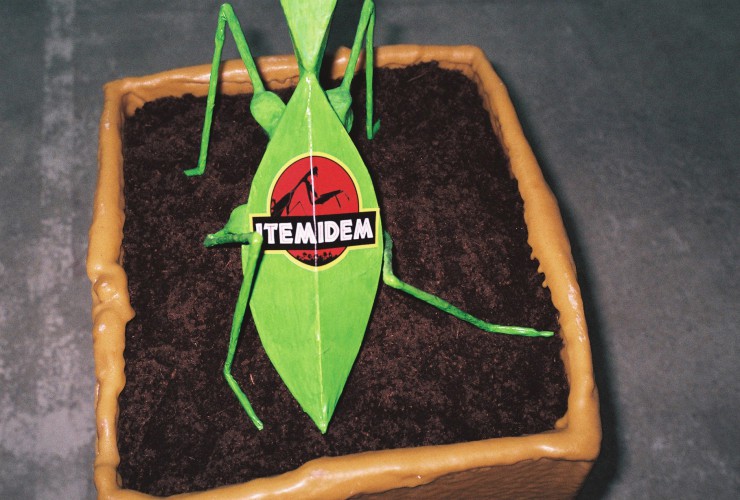 ITEM IDEM and Master Au Yeung Ping Chi, Superorder Dictyoptera II, 2016. Bamboo sticks, rice paper, branded sticker, Monsanto seeds, soil, cardboard, polyurea hybrid elastomer, paint
ITEM IDEM and Master Au Yeung Ping Chi, Superorder Dictyoptera II, 2016. Bamboo sticks, rice paper, branded sticker, Monsanto seeds, soil, cardboard, polyurea hybrid elastomer, paint
Favorite memory?
My first boyfriend and I had buried a kitsch sculpture of two dolphins on a beach in Normandy as a symbol of our engagement. Two years later, we hitched back there but couldn’t find it anymore as of course, the beach had moved slightly. A storm broke up, and we gave it a last attempt with the shovel, miraculously uncovering the small statue! This felt like a moment of eternal bliss that I will always remember. I also have a personal anecdote with Rei Kawakubo, but I will keep this one for another day!
Worst habit?
Caring too much. About everything. I did train a little as a Zen apprentice, but I am still so far from being a free man.
What is next for you?
Working on a potential residency project next spring in Shenzhen with a Chinese art museum. I’d like to deepen my research on the funeral paper craft among other things, and create ties with factories and makers to push my own production further. So a long stay around PRD (‘Pearl River Delta’) is exactly what I need.
And lastly…where do you find beauty?
Literally anywhere. But mostly in the uncommon, the uncanny, the accidental and the unexpected. I don’t like predictions, and I’m equally hoping to not be predictable either.
Visitez:
http://www.instagram.com/item_idem/
www.thebreedersystem.com/exhibition-details/item-idem-show

